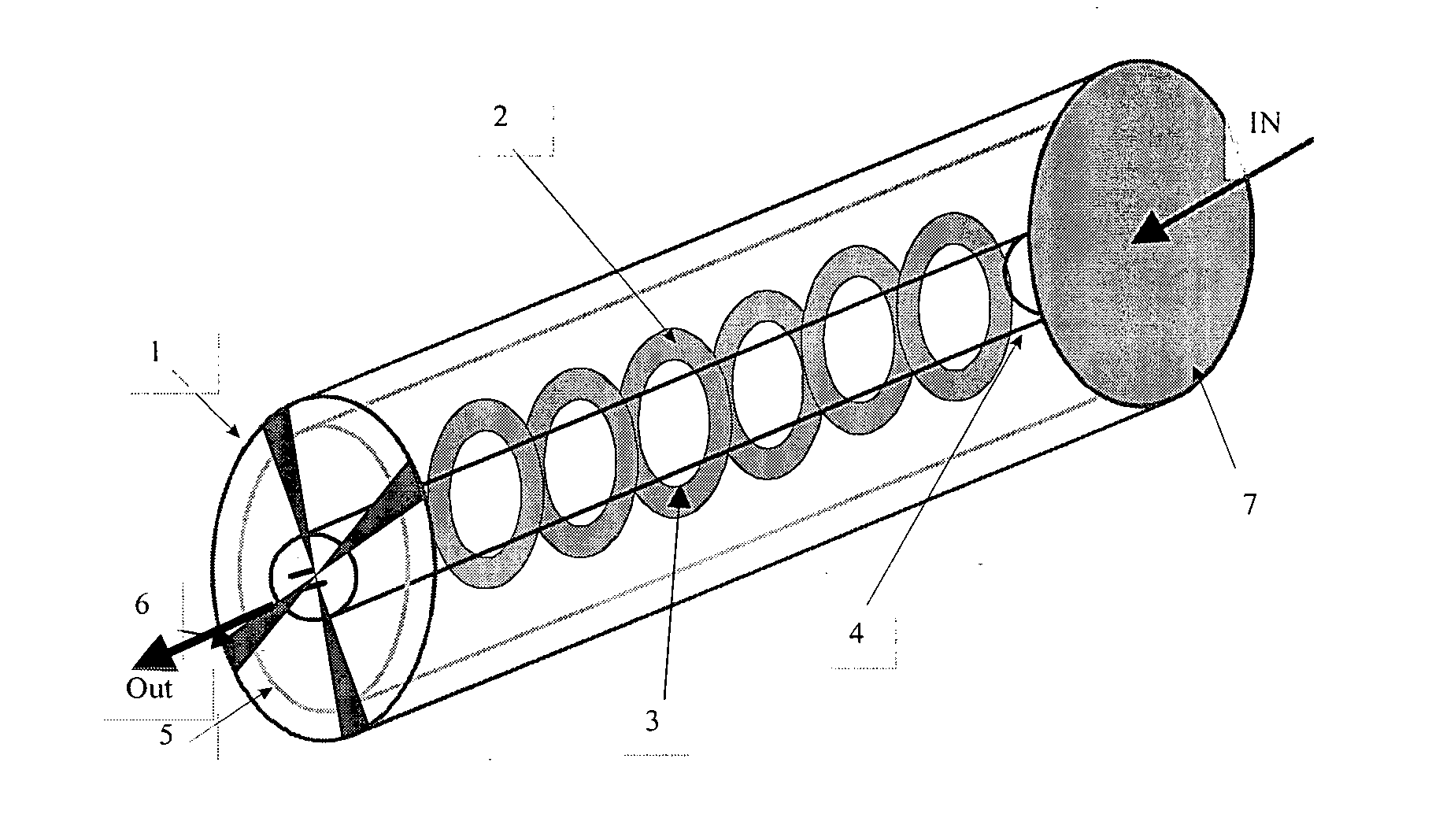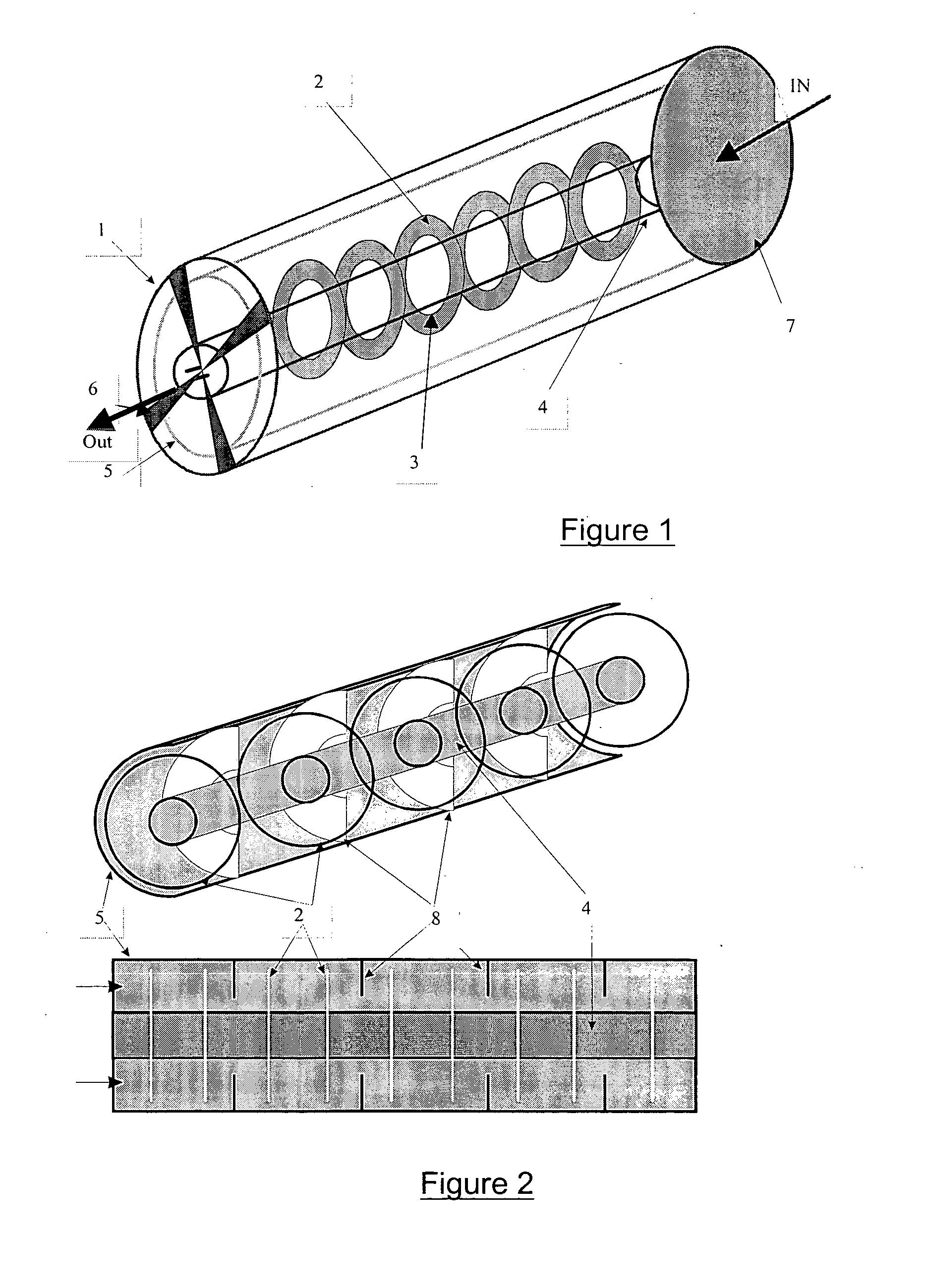Device and process for the purification of a gaseous effluent
a technology of gaseous effluent and device, which is applied in the direction of energy-based chemical/physical/physical-chemical processes, chemical/physical/physical-chemical processes, dispersed particle separation, etc., can solve the problems of limiting the active surface area of the photocatalyst, which is actually accessible both to the incident light and to the gas, and competition of organic contaminants for the active sites. , the effect of reducing the effect of oxidative stress
- Summary
- Abstract
- Description
- Claims
- Application Information
AI Technical Summary
Problems solved by technology
Method used
Image
Examples
example 2
[0127] First Embodiment of the Device According to the Invention
[0128] This first embodiment is described with reference to the representation in perspective of FIG. 1. Rings (2) with an external diameter of 35 mm comprising a circular opening (3) with a diameter of 15 mm at their center are first obtained by cutting out either aluminum sheets with a thickness of 100 .mu.m degreased with methanol or filter papers (Whatman No. 5) and are then coated with catalyst in accordance with the method of example 1.
[0129] A cylindrical glass reactor (1) with a length of 25 cm and an internal diameter of 4 cm is equipped with rings (2)--six of which are represented in FIG. 1--acting as catalytic supports, placed along a source (4) composed of a fluorescent tube (UV A Cleo 15 watts, sold by Philips) with a diameter of 15 mm and separated from one another by approximately 12 mm. A reflector (5) can be installed against the internal wall of the reactor (1). A fan (6) and a filter (7) are placed at...
example 3
[0130] Second Embodiment of the Device According to the Invention
[0131] This second embodiment is described with reference to FIG. 2, which gives a representation in perspective (top view) and a longitudinal section (bottom view) of it. It comprises, in addition to the elements already present in FIG. 1, indicated by the same numbers and with the same dimensions as in example 2, baffles (8) formed of rings with an external diameter of 4 cm for an internal opening with a diameter of 2 cm. These baffles (blocking means) are inserted every two rings (2) and are in direct contact with the wall of the reactor (1). A fan (6) and a filter (7) (not represented in FIG. 2) can be placed at the ends of the reactor (1) as in example 2.
example 4
[0132] (Comparative)--Device According to the Prior Art
[0133] A reactor with the same external dimensions as that of examples 2 and 3 and in accordance with U.S. Pat. No. 5,790,934 is described with reference to FIG. 3, which gives a representation in perspective with transverse section (top view) and a representation in open perspective (bottom view) of it. Comprising the elements already present in FIG. 1 and represented by the same numbers, it is obtained by replacing the rings (2) with six equidistant (that is to say, forming an angle of 60 degrees with one another) longitudinal fins (9) positioned radially with respect to the tube (4) and occupying the entire space between the tube (4) and the reflector (5) applied against the internal face of the reactor (1). A fan (6) and a filter (7) (not represented in FIG. 3) can be placed at the ends of the reactor (1) as in example 2.
PUM
| Property | Measurement | Unit |
|---|---|---|
| angle | aaaaa | aaaaa |
| flow rates | aaaaa | aaaaa |
| wavelengths | aaaaa | aaaaa |
Abstract
Description
Claims
Application Information
 Login to View More
Login to View More - R&D
- Intellectual Property
- Life Sciences
- Materials
- Tech Scout
- Unparalleled Data Quality
- Higher Quality Content
- 60% Fewer Hallucinations
Browse by: Latest US Patents, China's latest patents, Technical Efficacy Thesaurus, Application Domain, Technology Topic, Popular Technical Reports.
© 2025 PatSnap. All rights reserved.Legal|Privacy policy|Modern Slavery Act Transparency Statement|Sitemap|About US| Contact US: help@patsnap.com



